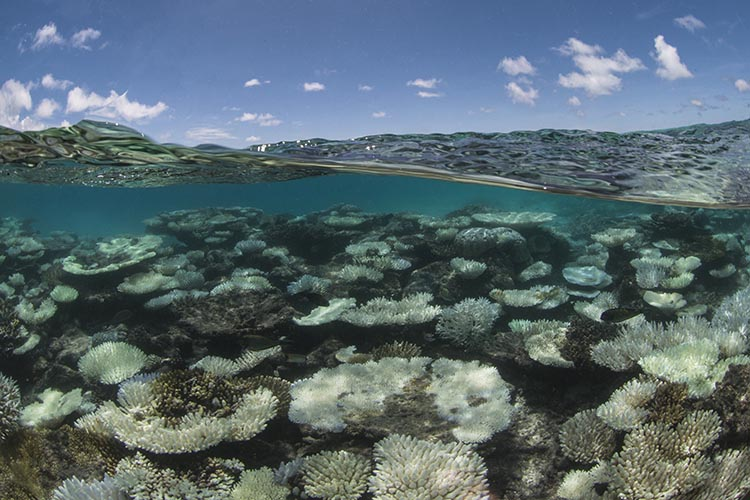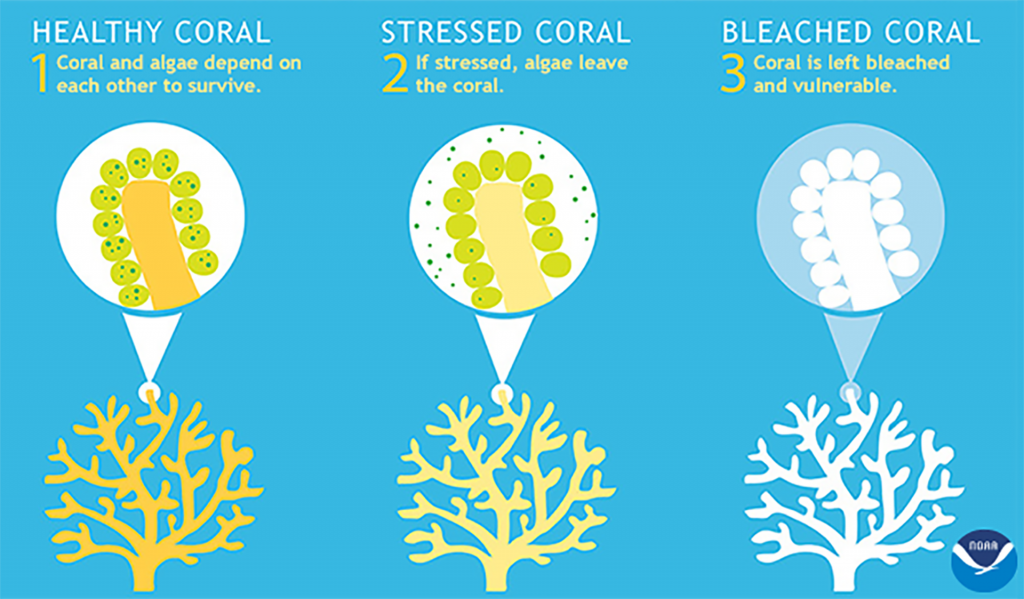Description

Disclaimer: Copyright infringement not intended.
Context:
- National Oceanic and Atmospheric Administration’s (NOAA) Coral Reef Watch (CRW) and the International Coral Reef Initiative (ICRI) have confirmed the occurrence of the fourth global mass coral bleaching event during 2023-2024.
How Coral Bleaching Happen?
- Hard corals, characterized by a tough shell covering, host single-celled algae in a symbiotic relationship, imparting them their characteristic color.
- Rising sea surface temperatures lead to the expulsion of algae, causing corals to turn white, a process known as bleaching.
- Bleached corals become vulnerable to diseases and eventual death, impacting the millions of marine species dependent on them for habitat and ecosystem services.

Causes of Coral bleaching:
- Rising Sea Surface Temperatures:
- Increasing global temperatures lead to elevated sea surface temperatures, triggering coral bleaching events where corals expel their symbiotic algae, causing them to turn white and become vulnerable to disease and death.
|
Intensified coral bleaching in 2023
●The year 2023 witnessed record-breaking heat in both the atmosphere and oceans, with nearly one-third of the global ocean experiencing marine heatwave conditions.
●El Nino conditions in the equatorial Pacific Ocean further intensified ocean warming, contributing to the severity of coral bleaching events.
●El Nino events, characterized by warmer-than-normal surface temperatures in the equatorial Pacific Ocean, are closely linked to mass coral bleaching incidents.
|
- Marine Heatwaves:
- Prolonged periods of unusually warm ocean temperatures, known as marine heatwaves, can intensify coral bleaching events and cause widespread damage to coral reef ecosystems, as seen during the recent global mass bleaching event.
- Ocean Acidification:
- Elevated levels of atmospheric carbon dioxide (CO2) lead to increased absorption by oceans, resulting in ocean acidification. Acidic waters can weaken coral skeletons, making them more susceptible to damage from physical stressors and inhibiting coral growth and reef formation.
- Pollution:
- Runoff from agricultural activities, sewage discharge, and coastal development introduce pollutants such as sediment, nutrients, and chemicals into coral reef environments. Pollution can lead to coral disease outbreaks, algal overgrowth, and reduced water quality, further stressing coral reefs.
- Overfishing and Destructive Fishing Practices:
- Overfishing of herbivorous fish species, which play a crucial role in controlling algal growth on reefs, can disrupt the delicate balance of reef ecosystems, leading to coral smothering by algae. Additionally, destructive fishing practices such as blast fishing and cyanide fishing directly damage coral colonies and degrade reef habitats.
Way Ahead to Prevent Coral Bleaching:
Mitigation of Climate Change:
- Implement measures to reduce greenhouse gas emissions and mitigate climate change, including transitioning to renewable energy sources, improving energy efficiency, and enhancing carbon sequestration efforts.
Enhanced Marine Protected Areas (MPAs):
- Establish and expand marine protected areas (MPAs) to safeguard coral reef ecosystems from anthropogenic stressors such as overfishing, pollution, and coastal development, thereby enhancing their resilience to climate change impacts.
Sustainable Coastal Development:
- Adopt sustainable coastal development practices, including minimizing land-based sources of pollution, implementing coastal zone management strategies, and promoting sustainable tourism practices to reduce stress on coral reefs and their surrounding ecosystems.
Community Engagement and Education:
- Engage local communities, stakeholders, and policymakers in coral reef conservation efforts through education, outreach programs, and capacity-building initiatives. Empowering communities to actively participate in reef monitoring, management, and conservation can foster stewardship and promote sustainable livelihoods.
Research and Monitoring:
- Invest in scientific research, monitoring programs, and innovative technologies to better understand the drivers of coral bleaching, assess reef health and resilience, and develop effective management strategies. Long-term monitoring efforts can provide valuable insights into coral reef dynamics and inform adaptive management approaches to mitigate the impacts of bleaching events.
Source: https://www.downtoearth.org.in/news/climate-change/noaa-icri-confirm-fourth-global-mass-coral-bleaching-event-in-2023-2024-95591
|
PRACTICE QUESTION
Consider the following statements regarding coral bleaching and its causes:
- Coral bleaching is primarily caused by the release of toxins from marine algae, which disrupt the metabolic processes of coral polyps.
- Elevated sea surface temperatures can trigger coral bleaching by inducing stress in coral colonies, leading them to expel their symbiotic algae.
- Ocean acidification, resulting from increased atmospheric carbon dioxide levels, is a leading cause of coral bleaching as it directly damages coral skeletons, making them more susceptible to bleaching.
- Pollution from agricultural runoff and coastal development has no significant impact on coral bleaching, as corals are resilient to environmental pollutants.
Which of the above statements is/are correct?
A) 1 and 2 only
B) 2 and 3 only
C) 2 and 4 only
D) 1, 2, and 3 only
Answer: B)
|















